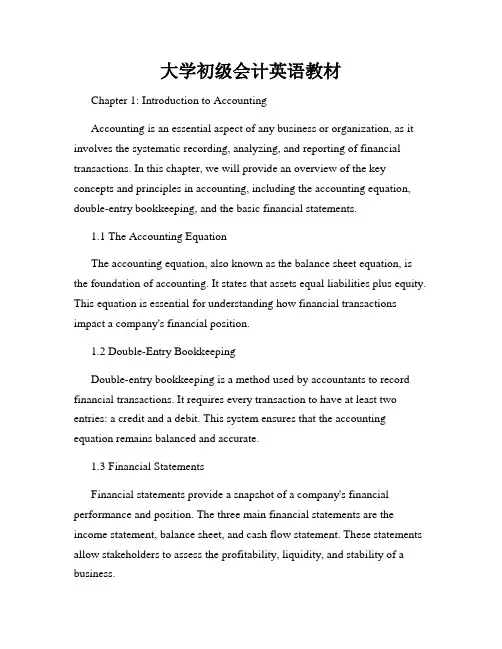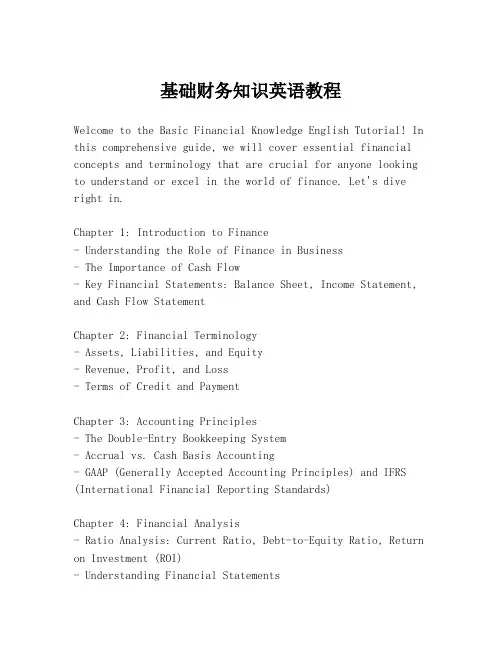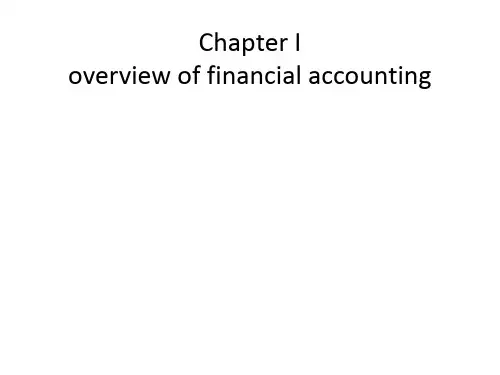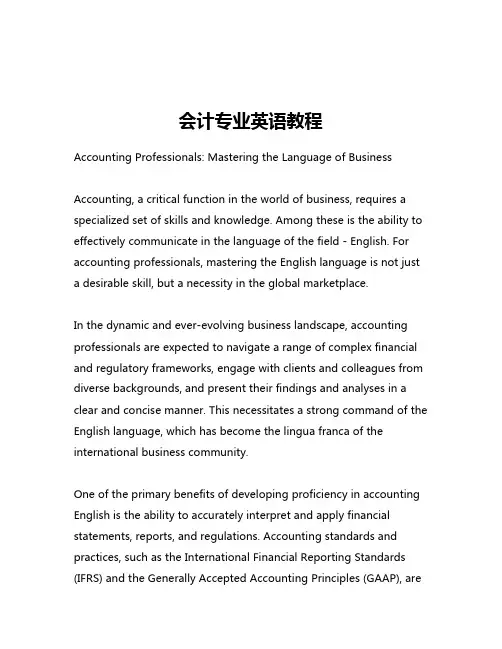中央财经大学会计专业英语教程Chapter1
- 格式:ppt
- 大小:840.04 KB
- 文档页数:45

大学初级会计英语教材Chapter 1: Introduction to AccountingAccounting is an essential aspect of any business or organization, as it involves the systematic recording, analyzing, and reporting of financial transactions. In this chapter, we will provide an overview of the key concepts and principles in accounting, including the accounting equation, double-entry bookkeeping, and the basic financial statements.1.1 The Accounting EquationThe accounting equation, also known as the balance sheet equation, is the foundation of accounting. It states that assets equal liabilities plus equity. This equation is essential for understanding how financial transactions impact a company's financial position.1.2 Double-Entry BookkeepingDouble-entry bookkeeping is a method used by accountants to record financial transactions. It requires every transaction to have at least two entries: a credit and a debit. This system ensures that the accounting equation remains balanced and accurate.1.3 Financial StatementsFinancial statements provide a snapshot of a company's financial performance and position. The three main financial statements are the income statement, balance sheet, and cash flow statement. These statements allow stakeholders to assess the profitability, liquidity, and stability of a business.Chapter 2: The Accounting CycleThe accounting cycle is a series of steps that accountants follow to record, classify, and summarize financial transactions. In this chapter, we will explore each step in detail and discuss how it contributes to producing accurate and reliable financial information.2.1 Analyzing and Recording TransactionsThe first step in the accounting cycle involves analyzing and recording financial transactions. Accountants review supporting documents, such as invoices and receipts, and identify the appropriate accounts to record the transactions.2.2 Posting to the General LedgerAfter recording transactions, accountants post the information to the general ledger. The general ledger is a comprehensive record of all the accounts used in the accounting system. It provides a complete overview of a company's financial transactions.2.3 Adjusting EntriesDuring the accounting period, certain adjustments may be necessary to ensure that the financial statements reflect the correct financial position. Adjusting entries are made to account for items such as accrued expenses, prepaid expenses, and depreciation.2.4 Preparing Financial StatementsOnce all transactions are recorded and adjusted, accountants can proceed to prepare the financial statements. The income statement reports thecompany's revenues, expenses, and net income, while the balance sheet presents the assets, liabilities, and equity. The cash flow statement shows the inflows and outflows of cash.Chapter 3: Cost AccountingCost accounting is a branch of accounting that focuses on the analysis of costs for decision-making purposes. This chapter introduces the basic concepts and techniques used in cost accounting.3.1 Cost ClassificationCosts can be classified into various categories, such as direct costs, indirect costs, variable costs, and fixed costs. Understanding these classifications is crucial for accurately calculating and analyzing costs.3.2 Cost-Volume-Profit AnalysisCost-volume-profit (CVP) analysis is a tool used to examine the relationship between costs, volume, and profits. It helps managers make informed decisions regarding pricing, production levels, and cost control.3.3 Costing MethodsDifferent costing methods, such as job costing, process costing, and activity-based costing, are used to allocate costs to products or services. Each method has its advantages and is suitable for different types of businesses.Chapter 4: Financial Statement AnalysisFinancial statement analysis involves examining a company's financial statements to assess its financial health and performance. This chapter explores the various tools and ratios used in financial statement analysis.4.1 Ratio AnalysisRatio analysis involves calculating and interpreting financial ratios, such as liquidity ratios, profitability ratios, and solvency ratios. These ratios provide insights into a company's liquidity, profitability, and ability to meet its long-term obligations.4.2 Vertical and Horizontal AnalysisVertical analysis compares each item on a financial statement to a base item, usually expressed as a percentage. Horizontal analysis, on the other hand, compares financial statement items across multiple periods to identify trends and changes.4.3 Limitations of Financial Statement AnalysisWhile financial statement analysis is a valuable tool, it does have limitations. Factors such as industry-specific considerations, accounting policies, and non-financial factors should also be considered when evaluating a company's financial performance.ConclusionThis introductory accounting textbook covers the fundamental concepts and principles of accounting, the accounting cycle, cost accounting, and financial statement analysis. It provides students with a solid foundation inaccounting principles and practices, preparing them for further study or a career in accounting.。

基础财务知识英语教程Welcome to the Basic Financial Knowledge English Tutorial! In this comprehensive guide, we will cover essential financial concepts and terminology that are crucial for anyone looking to understand or excel in the world of finance. Let's dive right in.Chapter 1: Introduction to Finance- Understanding the Role of Finance in Business- The Importance of Cash Flow- Key Financial Statements: Balance Sheet, Income Statement, and Cash Flow StatementChapter 2: Financial Terminology- Assets, Liabilities, and Equity- Revenue, Profit, and Loss- Terms of Credit and PaymentChapter 3: Accounting Principles- The Double-Entry Bookkeeping System- Accrual vs. Cash Basis Accounting- GAAP (Generally Accepted Accounting Principles) and IFRS (International Financial Reporting Standards)Chapter 4: Financial Analysis- Ratio Analysis: Current Ratio, Debt-to-Equity Ratio, Return on Investment (ROI)- Understanding Financial Statements- Break-even AnalysisChapter 5: Budgeting and Forecasting- Creating a Budget- Pro Forma Financial Statements- Forecasting Techniques: Top-Down vs. Bottom-Up ApproachChapter 6: Risk Management- Identifying Financial Risks- Hedging Strategies- Insurance and Contingency PlanningChapter 7: Investment Basics- Different Types of Investments: Stocks, Bonds, Mutual Funds - Portfolio Diversification- Understanding Market Indices and Economic IndicatorsChapter 8: Taxation in Finance- Corporate and Personal Income Tax Basics- Deductions and Tax Credits- International Taxation and Transfer PricingChapter 9: Financial Planning and Strategy- Setting Financial Goals- Capital Budgeting and Project Evaluation- Mergers, Acquisitions, and Corporate RestructuringChapter 10: Ethics and Regulations in Finance- The Role of Ethics in Financial Decisions- Regulatory Bodies: SEC, FINRA, and Others- Compliance and Anti-Money Laundering (AML) MeasuresChapter 11: Financial Technology (FinTech)- Online Banking and Mobile Payments- Blockchain and Cryptocurrencies- AI and Machine Learning in FinanceChapter 12: Career Opportunities in Finance- Job Roles in Finance: Accountant, Financial Analyst, Investment Banker- Continuing Professional Education (CPE) and Certifications: CPA, CFA, CMA- Networking and Professional DevelopmentEach chapter will provide you with a solid foundation in financial concepts, as well as practical examples and exercises to reinforce your learning. By the end of this tutorial, you will have a strong grasp of the English language as it is used in the financial industry, enabling you to communicate effectively in a professional setting.Remember, finance is a vast field with its own unique language. This tutorial is designed to be a starting point. As you progress, you are encouraged to delve deeper into specific areas of interest to further your expertise. Happy learning!。








会计专业英语教程Accounting Professionals: Mastering the Language of BusinessAccounting, a critical function in the world of business, requires a specialized set of skills and knowledge. Among these is the ability to effectively communicate in the language of the field - English. For accounting professionals, mastering the English language is not just a desirable skill, but a necessity in the global marketplace.In the dynamic and ever-evolving business landscape, accounting professionals are expected to navigate a range of complex financial and regulatory frameworks, engage with clients and colleagues from diverse backgrounds, and present their findings and analyses in a clear and concise manner. This necessitates a strong command of the English language, which has become the lingua franca of the international business community.One of the primary benefits of developing proficiency in accounting English is the ability to accurately interpret and apply financial statements, reports, and regulations. Accounting standards and practices, such as the International Financial Reporting Standards (IFRS) and the Generally Accepted Accounting Principles (GAAP), arepredominantly written and communicated in English. By mastering the terminology, syntax, and nuances of accounting English, professionals can better understand and comply with these standards, ensuring the accuracy and reliability of financial information.Moreover, effective communication in English is crucial for building and maintaining strong relationships with clients, colleagues, and regulatory bodies. Accounting professionals often find themselves in situations where they must present complex financial information to stakeholders, negotiate contracts, or collaborate with cross-functional teams. The ability to articulate ideas clearly, respond to questions, and negotiate effectively in English can be the difference between a successful engagement and a missed opportunity.In today's global economy, many accounting firms and organizations have expanded their reach beyond national borders, necessitating the ability to work with clients and partners from around the world. Proficiency in accounting English enables professionals to navigate these international landscapes, fostering cross-cultural understanding and facilitating seamless collaboration.Recognizing the importance of accounting English, educational institutions and professional bodies have developed comprehensive programs and resources to help aspiring and experiencedaccounting professionals enhance their language skills. These include specialized courses, language immersion programs, and online resources that focus on the unique vocabulary, grammar, and communication strategies required in the accounting field.By investing in the development of their accounting English proficiency, professionals can unlock a world of opportunities. They can expand their career prospects, engage in international projects, and contribute to the success of their organizations on a global scale. Furthermore, the ability to effectively communicate in English can lead to increased job satisfaction, as professionals are better equipped to navigate the complex and dynamic world of accounting.In conclusion, the mastery of accounting English is a crucial skill for professionals in the field. It enables them to accurately interpret and apply financial standards, build strong relationships with clients and colleagues, and thrive in the global business environment. By embracing the importance of accounting English and dedicating themselves to its development, accounting professionals can position themselves for success and contribute to the ongoing evolution of the accounting profession.。
